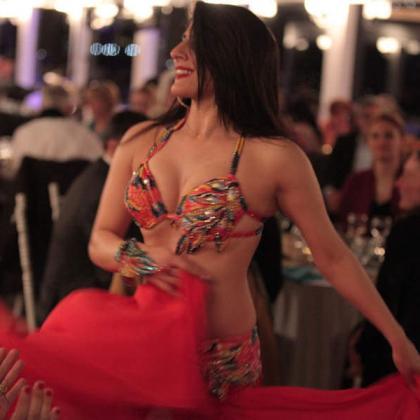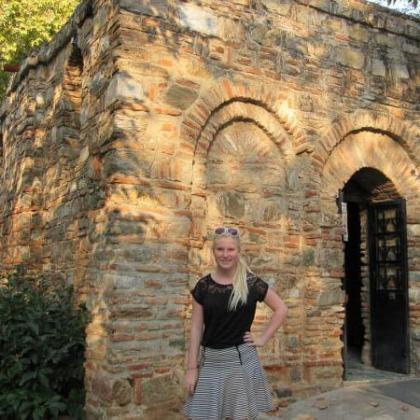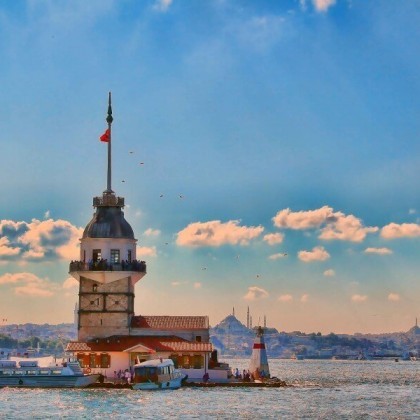Kayseri
Even though Kayseri (pop. 500,000) is easily Cappadocia’s largest metropolis, wide streets and large public spaces save the city from claustrophobia and overcrowding. In spite of Kayseri’s accumulation of fascinating attractions over the course of its 6000-year history, foreign visitors (though welcome) are unusual here. Despite its Westernized appearance, the city is culturally and religiously conservative; entertainment is scarce, and female tourists should adhere to the dictates of traditional dress. With few tourist traps, this renowned carpet center could be your one-stop shop for cheaper buys than those in Istanbul.
Originally the capital of an independent Cappadocia, the city was renamed Cae saria under the reign of the Roman emperor Tiberius Caesar (14-37 AD). Like most other cities in Anatolia, it then passed from the Romans to the Byzantines, and later to the Selçuks. Kayseri (a derivative of the town’s Roman name) blossomed under Selçuk rule. As an important post along trade routes, Kayseri amassed the wealth that financed such 13th-century monuments as the Ilunat Ilatun Complex and the Gevher Nesibe Tibbiyesi, the world’s first medical university.
Istanbul New Year’s Eve Party Cruise on the Bosphorus
IstanbulWith this new year's eve party program in Istanbul, you will have an amazing new year party on the Bosphorus. Book it now and don't miss the special price!
View Tour3 Days Ephesus, Pergamon and Pamukkale Tour Package
Ephesus, Pamukkale, PergamonIf you want to make an amazing trip to the Ephesus, Pergamon, and Pamukkale, you should read our tour itinerary.
View TourIstanbul and Cappadocia Tour – 7 Days
Istanbul, Cappadocia, TurkeyIf you want to make a trip to Istanbul and Cappadocia both, we strongly suggest you join this amazing package tour. This tour covers all the accommodations, transportations, lunches...
View TourBest of Turkey Package Tour – 8 Days
Istanbul, Cappadocia, Ephesus, PamukkaleAre you looking for a good traveling package in Turkey? With our 8-days Turkey tour, you will make a trip to every important sight in Turkey. Enquire now for...
View TourTRANSPORTATION
Flights: Erkilet Airport (338 33 53), 90km northeast of Kayseri down Sivas Cad., is the most organized in Cappadocia. To İstanbul (11hr.; daily 9:55am, 9pm; $84, students $67). Buy tickets from the THY Office, 1 Yıldırım Cad. (222 38 58; fax 222 47 48) which also offers an airport shuttle to the city for $1.60 (call ahead to arrange).
Buses: From the otogar (336 43 73), on Osman Kavuncu Cad. to: Adana (5hr., frequent 7am-lam, $8); Aksaray (21hr., frequent 9am-5pm, $5); Ankara (41/2hr., every hr. 7am-2am, $8); Antalya (12hr., frequent 5-11:30pm, $11,50); Bursa (10hr.; 6:30, 7:30pm; $13); Erzurum (9hr., frequent 7-1 1pm, $13); İstanbul (11hr., frequent 9am- 10:30pm, $17); İzmir (12hr., frequent 6pm-midnight, $17); Konya (5hr., frequent 8am-6pm, $8.20); Kuşadası (14hr., 6pm, $16); Mersin (5hr., frequent 7am-midnight, $8); Nevşehir (1hr., every hr. 7am-2am, $3); Sivas (2hr., express, every hr., $5); Trabzon (14hr., frequent noon-midnight, $15). Minibuses to Ürgüp leave from a stop on Osman Kavuncu Cad., near Düvenönü Meydanı (1hr., every 2hr. 8am-6pm, $2.50).
Trains: Kayseri’s gar (231 13 13), at the end of Hastane Cad., sends daily trains to: Adana (6hr.; 2:20, 4:40pm; $5); Ankara (8;hr.; midnight, 1, 4, 4:30am; $5); İstanbul (22hr.; 4, 4:40am; $7); and Kars (17hr 4:40pm, $7).
ORIENTATION
The otogar is on Osman Kavuncu Cad. which meets Park Cad. and İnönü Bul. at Düvenönü Meydanı. From Düvenönü Meydanı, Park Cad. leads to the massive kale, a Roman-era stone fortress which dominates the center of town. To the right is Nazmi Toker Cad., known as Bankalar Cad. for its many banks, where a massive underpass crosses Park Cad. Kayseri’s second main square, marked by the clock tower, is Cumhuriyet Meydanı, wThere Park Cad. meets Sivas Cad. and Seyyid Burhanettin Bui. heads away from the fortress, past the Hunat Mosque Complex and the tourist office to the Döner Kümbet (Revolving Tomb), the Archaeological Museum, and the Seyyid Burhanettin Türbesi (tomb).
PRACTICAL INFORMATION
- ATMs: All over Bankalar Cad., where you’ll get lira for your Cirrus/MC/Plus/V.
- Hospitals: Erciyes Tıp Fakültesi Hastanesi (437 49 01 or 437 4902), Özel Gülhane Sağlık Merkezi, 24 Kiçikapu Cad. (222 48 54 or 222 48 35), and Hunat Sağlık Merkezi (221 06 00), next to the Hunat Hatun Complex. All have ambulance services and English-speaking doctors.
- Emergency: call 336 27 50.
- Internet Access: There are a number of Internet cafes in the residential area north of Sivas Cad. and east of the THY office. Slow access costs around $.50 per hr.
- PTT: On Sivas Cad. in Cumhuriyet Meydanı. 24hr. phones. Poste Restante. Telegraph, fax, and currency exchange daily 8:30am-5pm.
Postal Code: 38000.
ACCOMMODATIONS
Since Kayseri is not a backpackers’ town, the fancy hotels and even the cheaper, spartan ones tend to be overpriced. Most hotels will negotiate a discount for business groups, but rarely for students. Hotel prices increase by about 25% in the winter, as most visitors (whether businessmen or skiers) come with the snow.
Hotel Yat, 14 Talas Cad. (232 73 78 or 232 35 95). has 8 bright, balconied rooms, with orange phones and blue and green walls. Bath $2. Singles $5; doubles $10. Hotel Hisar, 24 Osman Kavuncu Cad. (336 66 44) has several stories of clean but bare rooms, surrounding a skylit central atrium. Free laundry service. $10 per person.
Hotel Sur, 12 Talas Cad. (222 43 67; fax 231 3992). Inside the old town, by the Ethnographic Museum. Central location and 2-star comfort. Singles $12; doubles $20. 0 Hotel Çamlıca, Bankalar Cad., 14 Gürcü Sok. (232 34 93 or 232 23 54; fax 231 43 44). Bright lounge, palm-tree murals and 70s posters will make you feel like one of Charlie’s Angels. Your mission? To conquer the shared a la turka toilets at the end of the hall. Breakfast included. Singles $11, with shower $13; doubles $23, with shower $24.
FOOD
Kayseri is the present-day capital of Turkish cold cuts. This is the place for pastırma (spicy, salted, sun-dried beef or veal with garlic, pepper, and parsley; $4 per kg), sucuk (extremely spicy, well-salted beef sausage resembling a long, thin salami; $3 per kg), and salam (salted Turkish salami, similar to sucuk but less spicy). Inexpensive picnic fare is also easy to find, as the many bread shops sell loaves of fresh bread for about $.20. Vegetarians might consider the specialty cheese, tulum peyniri, or bal (honey; $2.50-3.25 per jar), both sold at most food stores. For dessert, try Kayseri’s special kaymaklı ekmek kadayıfı (fluffy, honey saturated bread topped with sweetened cream; $1.50), which is not as unbearably sweet as many Turkish desserts. Many inexpensive restaurants line the back streets parallel to Bankalar Cad. Kayseri is not a city that parties until dawn; even most of the restaurants shut down by 10 or 11pm.
İskender Kebap Salonu (231 27 69 or 222 69 65), on Millet Cad. behind the fortress. Overwhelmingly recommended by locals, this glossy 3-story restaurant serves an unbeatable meal of İskender kebap (thin layers of butter-soaked meat blanketing pide bread and served with yogurt) and a tall, foaming ayran for just $3.50. Placemats explain the history of İskender kebap, for devoted meat historians.
Divan Pastanesi (222 39 74). An incredible chain of pastry shops. The best one is just around the corner from İskender Kebap Salonu. Cases of sweets, breads, and pastries hug the sleek glass and metal furniture. Open M-Sa 7:30am-10pm, Su 7:30am- 9pm.
Urfa Sofrasi, around the corner from İskender, serves up tasty versions of standard Turkish dishes for about $4. The menu provides pictures of each dish, so consider holding on to it after ordering to study up for future restaurant excursions.
GEVHER NESİBE TÜRBESİ
In May 1993, NASA named a newly discovered mountain on Venus after the Selçuk princess Gevher Nesibe Sultan in recognition of her contribution to modem science. When she died of tuberculosis in 1204, her elder brother, Giyasettin Keyhüsrev Sultan, commissioned a medical center in her name. The Gevher Nesibe Tibbiyesi opened in 1200 as the world’s first medical school and most technologically advanced hospital. The hospital treated everyone for free, and patients, doctors, and medical students were admitted regardless of religion. Today its two seminaries house the Erciyes University Medical Museum, where you can take a tour of a 13th-century operating room, mental ward, clinic, and hospital. Considering the many difficulties of running a large-scale hospital in the era before electricity, the scope and scale of the facility are impressive. The skylight in the ameliyat hane (operating room) concentrates maximum sunlight on the operating table. The equally well-planned hamam managed to heat both halves of the building during Kayseri’s snowy winters. Perhaps most remarkably, the akıl hastanesi (mental hospital) is equipped with one of the earliest known P.A. systems: sound vents in the upper comers of the stone cells enabled a single person upstairs to address all the patients at once. This seminary is not without a tomb of its own look out for the low-flying sparrows when descending the stairs to the Gevher Nesibe Sultan Mescidi ve Sandukası (little mosque), where the princess is interred. Other alcoves are dedicated to relevant quotations from the Qur’an (“Whoever saves one life has in a way resurrected us all”) and hospitals founded by Turkish women (from Gevher Nesibe to Valide Sultan in 1845). Atatürk’s last brushes with the medical world are also memorialized, including a photo of a syringe, labeled (in Turkish), “The last injection of extrait hepatique administered to Atatürk before his death by Dr. M.K. Berk.” (From Park Cad., cut north across Atatürk Parkı and Mimar Sinan Parkı. Open Tu-Su 8am-5pm. $1.25, students $.75.)
HUNAT HATUN COMPLEX
Early in the 13th century, Alâadin Keykubad, Sultan of the Anatolian Selçuks (1219-1237), captured the Alanya fortress from its Persian ruler, Kir Vart. One of the conditions of Vart’s surrender was that his daughter Hunat (“lady” in Persian) Mahperi Hatun would become the sultan’s wife. After her marriage, Lady Hunat (as she is redundantly called in English) converted to Islam and commissioned the Hunat Hatun Complex (Külliyesi), made up of the Hunat Hatun Camii, Türbe (tomb), Medrese, and Hamam, which is still functioning and has separate facilities for men and women. (In the center of town, across from the kale. 231 58 05. Hamam open daily 8:30am-5:30pm. Bath $2.50; massage and scrub $2.50.)
GÜPGÜPOĞLU KONAĞI AND ETHNOGRAPHIC MUSEUM
Built in the 15th cen¬tury’ and later expanded, the Güpgüpoğlu Konağı is a beautifully preserved Ottoman mansion, built in 1419. Stroll through the replica kitchen, sitting room, and bride’s room, where mannequins in period dress evoke a sense of the life and times of the Ottoman upper crust. Converted into the Ethnographic Museum, the rest of the mansion houses a significant, collection of coins, guns, costumes, and household objects, mostly from the Ottoman period. (Staying Inside the old city walls, head south from the kale about 150m, just beyond Hotel Sur. Güpgüpoğlu Konağı 222 95 16. Museum -a222 21 49. Open Tu-Su 8:30am-5pm. $1.60.)
ARCHAEOLOGICAL MUSEUM
The first of two halls in this small, fascinating museum displays objects from the Early Bronze Age, along with treasures unearthed from nearby Kültepe, a 6000-year-old settlement that peaked as an Assyrian trading colony (2500-1750 BC). Among the pottery and metalwork are some tablets bearing the earliest writing found in Anatolia, dating to the Neo-Hittite Period. The ceriteipiece of the second hall is the Heracles Sarcophagus, a large marble tomb depicting the 12 labors of Heracles. (Head down Talas Cad., turn left at Kışla Cad., and follow the signs to the museum. s222 21 49. Open daily 8:30am-5pm. $1.)
CITADEL
First built by the Byzantines in the 6th century, and improved upon by the Selçuks, the massive kale is Kayseri’s most distinctive landmark and houses its most budget-friendly bazaar. Replete with countless jewelers and cobblers, the kale is connected to the even larger, centuries-old covered markets nearby. The oldest, built in 1497, is the Bedesten bazaar, near the Ulu Camii. It’s connected to the Vizier Kervansaray (1723), which still bustles with wool traders and craftsmen.
MOSQUES
West of the fortress, past the bazaar, the Ulu Camii (Great Mosque, a.k.a. Camii Kebir or Sultan Cami), constructed in 1134, is Kayseri’s oldest mosque. Built on 42 stone pillars by Melik Mehmet Gazi Danişmendoğulları, this mosque’s minarets stand 46m high. In the northwest corner of Atatürk Parkı, the Kurşunlu Camii (built in 1585) is the only piece of architecture in Kayseri designed by hometown hero Mimar Sinan Eseri (1492-1588), Turkey’s most famous architect (see Ottoman Architecture, p. 37). Though far smaller than the city’s other major mosques, the delicate arches and graceful design are clearly the products of a great master. Next to the kale, the immense and beautiful Bürüngüz Camii is a 20th-century imitation of the Blue Mosque in Istanbul. As with all mosques, visitors ought to dress conservatively (women preferably with head scarves), remove their shoes before entering, and speak softly while inside.
TOMBS
One of Kayseri’s distinguishing features is its wealth of preserved Selçuk tombs. Probably the most interesting is the 13th-century Döner Kümbet (Revolving Tomb), on a traffic island down Talas Cad. on the way to Erciyes, south of the kale. The 12-sided, cone-roofed tomb does not revolve, but it is said that the pure of heart will see it slowly rotating early in the morning. Though visitors are not allowed inside the tomb, they can peer through a metal grate in the wall.
The sacred Seyyid Burhanettin Türbesi was built in the early-13th century for Burhanettin Tirmizi (1165-1244), the first mevlevi at Hunat Hatun Medrese. This five-star tomb includes two separate and heavily trafficked prayer rooms for men and women. Inside, you’ll find the teacher’s enormous sarcophagus under a gargantuan chandelier and a beautiful dome decorated with rows of Selçuk floral designs. (Turn left at the Döner Türbesi to find the tomb nestled in a little park. Remember to leave your shoes by the door or carry them in a bag. Women may want to wear a head scarf.)
DAYTRIPS FROM KAYSERI
SULTAN HAN
Sultan Han is about 45km from Kayseri, and less than lkm from the Kayseri-Slvas highway.To get there, catch one of the Kayseri-Sivas buses and ask to be let off at Sultan Han (every hr., $3). To return to Kayseri, flag down the Sivas-Kayseri minibus at about 20min. past the hour. Open Tu-Su 9am-lpm and 2-6pm. $.60.
The 13th-century Sultan Han, Turkey’s second largest kervansaray, served as a safe haven for traveling merchants during the Selçuk period (set Selçuk Architecture and Decorative Arts, p. 37). Built in 1255 by Vizier Celeddin Karatay, the building now echoes with the incessant calls of bats from the great hall, replacing the murmurs of road-weary travelers and traders. After walking through the old guest quarters and hamam, notice the intricate snake patterns on the eyvans (arches) of the mosque in the courtyard. Be sure to climb the stairs to check out the roof and the dome over the great hall.
ERCİYES DAĞI (MOUNT ERCIYES)
To get to Erciyes, take the Kayseri-Develi dolmuş. The best place to catch it is the small local otogar behind Hotel Yat. The dolmuş leaves as soon as the driver decides It’s full, (usually every 30min. 7am-9pm, $.80). Ask to be let off at Kayak Evi. Lifts open daily 8am- 5pm. $2 to top. Day pass $15; ski rentals $12.
The snow-capped heights of Erciyes Mountain are clearly visible from Kayseri and serve as a perpetual reminder of the volcanic fury that shaped the Cappadocian landscape. At 3917m, the extinct volcano is the tallest mountain in Central Anatolia. From late October through March, skiers flock to the 2215m high Tekir Yaylası (ski track), equipped with two chair lifts, two teleskis, and three beginner’s lifts. The accessible part of the mountain runs from the ski base to a point 2770m high and offers skiers altitude of about 550m and heavenly trail conditions. The Sağlık Ocağı first-aid clinic (342 20 31) caters to winter emergencies. The Kardelen Restaurant and Disco Bar (342 21 01) at the ski base, is open year-round, though summer meal selections are limited. A true hot spot, Kardelen never loses its party spirit; the disco downstairs pulsates even when sheep are the only passers-by.
In the summer, hiking groups trek the mountain from the ski base up. While experienced mountaineers may climb the west face to the summit (8hr. up; 3hr. down), the melting snow and falling rock render this a dangerous route. Alternatives include a shorter hike to the mountain’s bowl and back (8hr.) or a tougher south-side climb to the summit. In any case, be sure to wear sturdy boots and dress in layers. Kayak Evi , the year-round hotel at the base of the ski slopes, helps arrange hikes. Groups can call ahead and speak with Veysel, the hotel’s Turkish- and German-speaking ski instructor, to arrange a guided hike. (342 20 31; fax 342 20 32. Guided hikes $15 per person. $10 per person. Hot-water for groups only; no meals. In winter $35 per person, including bath and meals.) Independent travelers may have problems with logistics, and a trekking tour arranged elsewhere ahead of time may be the best way to attack Erciyes.





